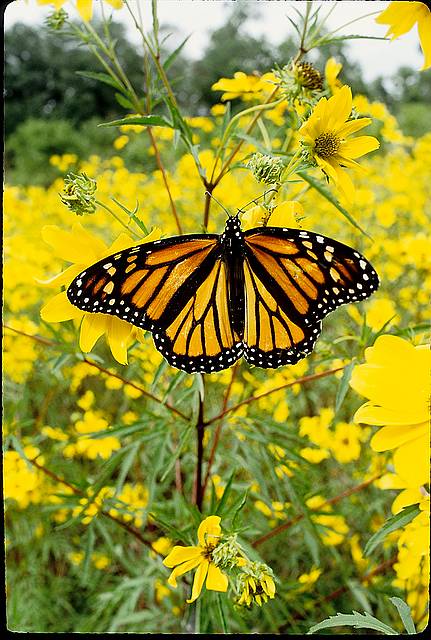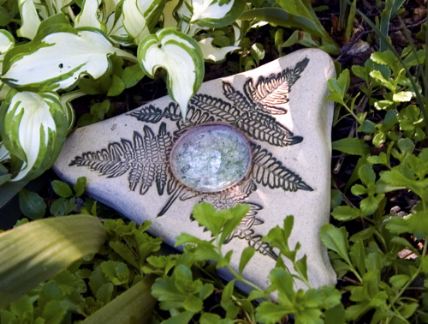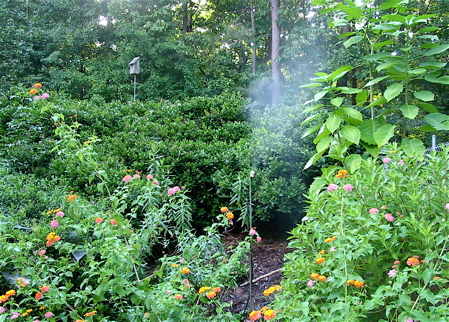-
use butterfly feeders along with leaf misters
Enticing butterflies has become a huge past-time for many gardeners and backyard birders alike. Earning nicknames like “flying flowers” and “winged jewels” these graceful beings bring joy and delight to many with their sheer presence. But what really works to bring butterflies to your place? There’s butterfly houses, and butterfly feeders, and butterfly baths, and puddlers too!
Although I’m no expert, during summer months you’ll find daily butterfly activity in our garden that’s pretty amazing. We have no butterfly house, nor do we use a feeder. The secret is a leaf mister and flowers which provide food in the form of nectar. Host plants are extremely important too – this is where butterflies lay their eggs. Host plants also provide a food source for the emerging caterpillar. Be forewarned though…heavy munching will occur on your host plants.
We see mostly Monarchs and Swallowtails, and Milkweed serves as the host plant. Lots of native shrubs and flowers entice butterflies and keep them around all season. Mature White Fringe Trees line the back yard, Service Berry shrubs sit in the front, Columbine, Trumpet Vine, Native Hibiscus, and Bottlebrush are just a few other plantings around the yard.
Butterflies do adore over-ripened fruit like bananas, oranges, melon and pears, but you must be sure the fruit does not mold. Butterfly puddlers are popular too, but it’s rare that they’ll drink from an open water source. Instead, the clay absorbs the water, and butterflies will sit upon the dampened clay surface. If using a but
terfly feeder, it should have a wick to absorb and draw up nectar from the basin, as butterflies will eat from the wick.
This season create a butterfly habitat by planting a few native species that will help them thrive and flourish. Add a leaf mister and you’ll see the increase in activity. If you build it… they will come!
Our summer butterfly habitat -
Death in the Bat Caves:
Disease Still Wiping out Hibernating BatsScientists suggest a roadmap to tackle disease which has killed over one million bats
California, February 2011 – Conservationists across the United States are racing to discover a solution to White-Nose Syndrome, a disease that is threatening to wipe out bat species across North America. A review published in Conservation Biology reveals that although WNS has already killed one million bats, there are critical knowledge gaps preventing researchers from combating the disease.
WNS is a fatal disease that targets hibernating bats and is believed to be caused by a newly discovered cold-adapted fungus, Geomyces destructans, which infects and invades the living skin of hibernating bats. Since 2006 about one million bats across six species in eastern North America have died from WNS, and as a result several species of bats face endangerment or extinction.
“White-Nose Syndrome was first documented in 2006 in a tourist cave near Albany, New York. Dead and dying bats were then found in four nearby caves, 30 km west of Albany,” said lead author Janet Foley from the University of California, Davis. “By July 2010 G.destructans was identified in hibernating bats in 13 states as well as in Ontario and Quebec across the Canadian Border.”
Affected bat species include the endangered Indiana and gray bats (Myotis sodalis and M. grisescens), little brown bat (M. lucifugus) and the cave bat (M. velifer). Infection has also been confirmed in five species of bats in Europe, although no similar epidemic has yet been recorded.
The low temperatures and humid conditions of bat caves create ideal breeding grounds for this fungus, and in some bat colonies the mortality rate from WNS has been more than 95%.
“Some bats in infected bat colonies behave abnormally when infected, choosing to hibernate in exposed places, such as cave entrances or even flying during the day,” said Foley. “Bats regularly arouse from hibernation in order to drink, urinate and relocate. This causes them to burn up their only source of energy during winter, the body fats they stored prior to winter when insect prey was still available. Fungal infection might be leading to more frequent arousals from hibernation, causing infected bats to use up their fat reserves earlier, with potentially fatal consequences.”
Although the effects of the disease are all too apparent, there are critical knowledge gaps for researchers confronted with combating the disease. It remains unclear if G. destructans is the only pathogen involved, how it causes mortality, and its means of transmission. Some evidence suggests that people can move the fungus from cave to cave.
“Our study considers how epidemiology and disease ecology can help fill these knowledge gaps,” said Foley. “We believe that a roadmap including bat monitoring and disease surveillance, coupled with active research into finding ways to treat individual bats will be vital to combating this disease.”
“Based on current data, we believe that the culling of bats would be both premature and ill-advised. Instead we see efforts to conserve the genetic diversity of bat populations, combined with a program of educating the public to be key parts of the roadmap.”
Dr Foley’s team includes bat and disease ecologists from three different public agencies and academia and tries to make the point that creative, scientifically-sound ideas will be key to the success of any management plans. The group outlines an outbreak investigation framework that includes establishment of diagnostic standards, case definitions, and gathering of information on potential treatments for similar diseases.
The importance of monitoring bat population health is also stressed, as is improving public education and awareness of the disease, especially as many species of bats live in caves popular among tourists. If current declines in bat populations continue, the researchers expect strong reductions in the ability of bats to reduce insect pests and play important ecological roles in unique cave ecosystems.
The team also call for further studies of the chemical or biological agents that can kill the fungus, but have yet to be proven safe for bats.
“In the three years since its discovery WNS has changed the focus of bat conservation in North America,” concluded Foley.. “A national response is required and our epidemiological roadmap is designed to help inform state and national efforts to combat WNS across North America.”
This study is published in Conservation Biology. Media wishing to receive a PDF of this article may contact [email protected]
-
butterfly feeders and these!
It may be a little difficult to spot in the photo, but to butterflies that gentle spray from the leaf mister is absolutely irresistible!
Versatile for placement almost anywhere in the yard or garden, the rubber tubing is actually wrapped around a simple plant stake here. Our other mister extends over the railing of the front porch, coiled around a metal deck bracket.
The butterfly feeders in this yard are mostly natural. Consisting of host plants, like milkweed, butterflies may feast on nectar from perennial flowers like lantana, trumpet vine, and native hibiscus. There is also a staked glass butterfly feeder, and sometimes we’ll add over-ripened fruit. Melons, bananas, oranges and strawberries are a few of their favorites. The thing with fruit is to be sure it does not mold, which can be tricky in hot and humid Georgia summers. When the glass flower does not contain fruit, it’s easily moved near the leaf mister, and creates a small pool of water. This bath is frequented by the butterflies as well as hummingbirds and other songbirds.
If you’re not having such great success with butterfly feeders alone, definitely try a leaf mister. By creating an enticing butterfly habitat-you’ll be amazed at the bustling activity of these winged jewels!





